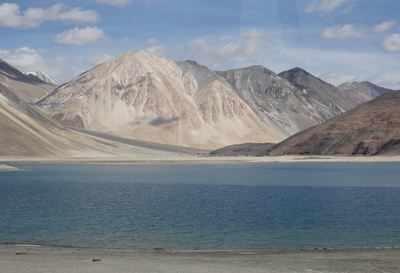
NEW DELHI: There has been a slight further reduction in the number of Chinese troops in the Pangong Tso area of eastern Ladakh but no discernible pullback, as in Galwan Valley and Gogra-Hot Springs, where ‘buffer zones’ have been created to prevent clashes between rival troops in the high-altitude region.
The initial withdrawal of Chinese soldiers from ‘Finger-4’ to ‘Finger-5’ area on the north bank of Pangong Tso, if and when it happens, will signal the completion of Phase-I of the de-escalation plan.
The PLA has pulled down some tents, moved back a few vehicles and slightly reduced its troops at Finger-4 but not vacated the area yet. The troop confrontation at the lake (at an altitude of 13,900 feet), in fact, is proving to be the toughest to resolve with over 3,000 PLA soldiers occupying the 8-km stretch from Finger-4 to 8 since early-May,” said a source.
According to security sources aware of the situation, there was a meeting between local authorities in Ladakh. The discussions were attended by the Ladakh administration, Army and ITBP officers. The problematic issue, which India rejects, is the Chinese expectation that Indian troops also pull back in equal measure. This means India will move back further from the LAC as it sees it while China only retreats from an area it has intruded upon. This could be a bargaining tactic but may prolong the process.
With India’s perception of the Line of Actual Control (LAC) running north to south at Finger-8, it wants PLA troops to pull back eastwards to their post at Finger-8 and permanent bases at Sirijap-I and II further beyond.
India has a post between Finger-2 and 3, along with an administrative base between Finger-3 and 4. But China, after building numerous fortifications and taking the heights from Finger-4 to 8, is claiming territory right up to Finger-2, from where it can threaten two crucial Indian roads.
“PLA had agreed to pull back from Finger-4 to 5 under Phase-I. Negotiations between local commanders are underway. The corps commanders may meet again to discuss Pangong Tso,” the source said. But there is progress in creation of so-called buffer zones at the other confrontation sites, with officials describing them as “temporary arrangements” to reduce the possibility of a clash without any permanent loss of territory or patrolling rights for India to allay concerns.
The first buffer zone was created at ‘Patrolling Point-14 (PP-14)’ in Galwan Valley, the site of the violent clashes on June 15, with the rival troops moving back 1.5 km each on Monday, as reported by TOI. On Wednesday, a similar no-patrolling zone came up at PP-15 in the Hot Springs area, with the rival troops pulling back about 2 km each.
The third zone at PP-17A at Gogra will take final shape by Thursday evening. These are just the “initial steps” in what will be a longdrawn de-escalation process. The eventual de-induction of rival troops massed along the LAC will extend to September-October even if there are no more flare-ups, as was earlier reported by TOI.
It’s only after “stabilisation” of the buffer zones at the different friction points, with physical verification as well as satellite surveillance, that the corps commanders are likely to meet again to decide the timelines and modalities for the next phase.
“Meanwhile, we will closely watch each other to build trust that was shattered by the June 15 clashes after the PLA went back on the earlier agreement to vacate PP-14,” another source said.
The initial withdrawal of Chinese soldiers from ‘Finger-4’ to ‘Finger-5’ area on the north bank of Pangong Tso, if and when it happens, will signal the completion of Phase-I of the de-escalation plan.
The PLA has pulled down some tents, moved back a few vehicles and slightly reduced its troops at Finger-4 but not vacated the area yet. The troop confrontation at the lake (at an altitude of 13,900 feet), in fact, is proving to be the toughest to resolve with over 3,000 PLA soldiers occupying the 8-km stretch from Finger-4 to 8 since early-May,” said a source.
According to security sources aware of the situation, there was a meeting between local authorities in Ladakh. The discussions were attended by the Ladakh administration, Army and ITBP officers. The problematic issue, which India rejects, is the Chinese expectation that Indian troops also pull back in equal measure. This means India will move back further from the LAC as it sees it while China only retreats from an area it has intruded upon. This could be a bargaining tactic but may prolong the process.
With India’s perception of the Line of Actual Control (LAC) running north to south at Finger-8, it wants PLA troops to pull back eastwards to their post at Finger-8 and permanent bases at Sirijap-I and II further beyond.
India has a post between Finger-2 and 3, along with an administrative base between Finger-3 and 4. But China, after building numerous fortifications and taking the heights from Finger-4 to 8, is claiming territory right up to Finger-2, from where it can threaten two crucial Indian roads.
“PLA had agreed to pull back from Finger-4 to 5 under Phase-I. Negotiations between local commanders are underway. The corps commanders may meet again to discuss Pangong Tso,” the source said. But there is progress in creation of so-called buffer zones at the other confrontation sites, with officials describing them as “temporary arrangements” to reduce the possibility of a clash without any permanent loss of territory or patrolling rights for India to allay concerns.
The first buffer zone was created at ‘Patrolling Point-14 (PP-14)’ in Galwan Valley, the site of the violent clashes on June 15, with the rival troops moving back 1.5 km each on Monday, as reported by TOI. On Wednesday, a similar no-patrolling zone came up at PP-15 in the Hot Springs area, with the rival troops pulling back about 2 km each.
The third zone at PP-17A at Gogra will take final shape by Thursday evening. These are just the “initial steps” in what will be a longdrawn de-escalation process. The eventual de-induction of rival troops massed along the LAC will extend to September-October even if there are no more flare-ups, as was earlier reported by TOI.
It’s only after “stabilisation” of the buffer zones at the different friction points, with physical verification as well as satellite surveillance, that the corps commanders are likely to meet again to decide the timelines and modalities for the next phase.
“Meanwhile, we will closely watch each other to build trust that was shattered by the June 15 clashes after the PLA went back on the earlier agreement to vacate PP-14,” another source said.
Download
The Times of India News App for Latest India News

Coronavirus outbreak
Trending Topics
LATEST VIDEOS
India
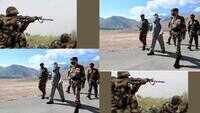 Army directs soldiers, officers to delete Facebook and Instagram accounts, uninstall 89 apps
Army directs soldiers, officers to delete Facebook and Instagram accounts, uninstall 89 apps 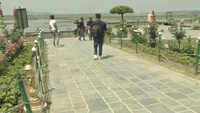 Unlock 2.0: Gardens, parks reopen in Srinagar
Unlock 2.0: Gardens, parks reopen in Srinagar 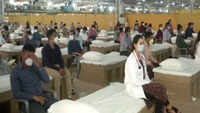 Furniture company donates 2000 beds for Radha Soami Satsang Beas COVID centre
Furniture company donates 2000 beds for Radha Soami Satsang Beas COVID centre 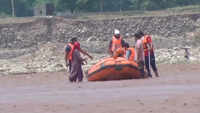 SDRF rescues woman stuck in flash floods in Jammu
SDRF rescues woman stuck in flash floods in Jammu  Amethi was bled dry, looted by Rajiv Gandhi Foundation in name of charity, public service: Smriti Irani
Amethi was bled dry, looted by Rajiv Gandhi Foundation in name of charity, public service: Smriti Irani 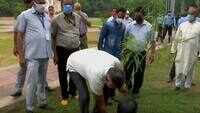 800 monuments still shut, reopening should be expedited: Tourism Minister
800 monuments still shut, reopening should be expedited: Tourism Minister
More from TOI
Navbharat Times
Featured Today in Travel
Quick Links
Coronavirus in MumbaiCoronavirus in KolkataCoronavirus in HyderabadCoronavirus in DelhiCoronavirus in BangaloreCoronavirus symptomsCoronavirus in IndiaWhat is CoronavirusCoronavirus NewsSolar EclipseNPRWhat is NRCCAB BillCAB and NRCRTI BillPodcast newsLok SabhaShiv SenaYSRCPCongressBJP newsUIDAIIndian ArmyISRO newsSupreme Court
Get the app



